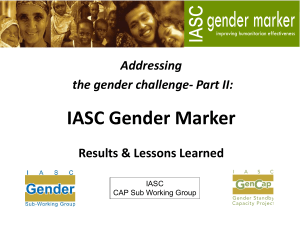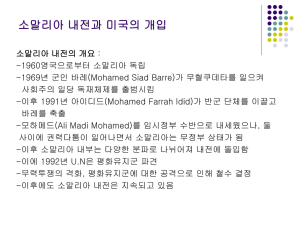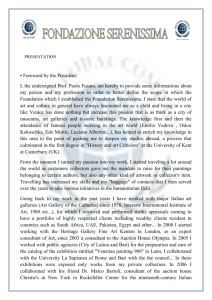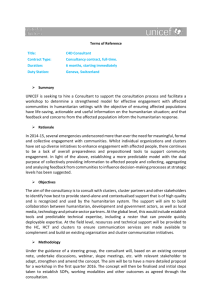4.2 The humanitarian strategy
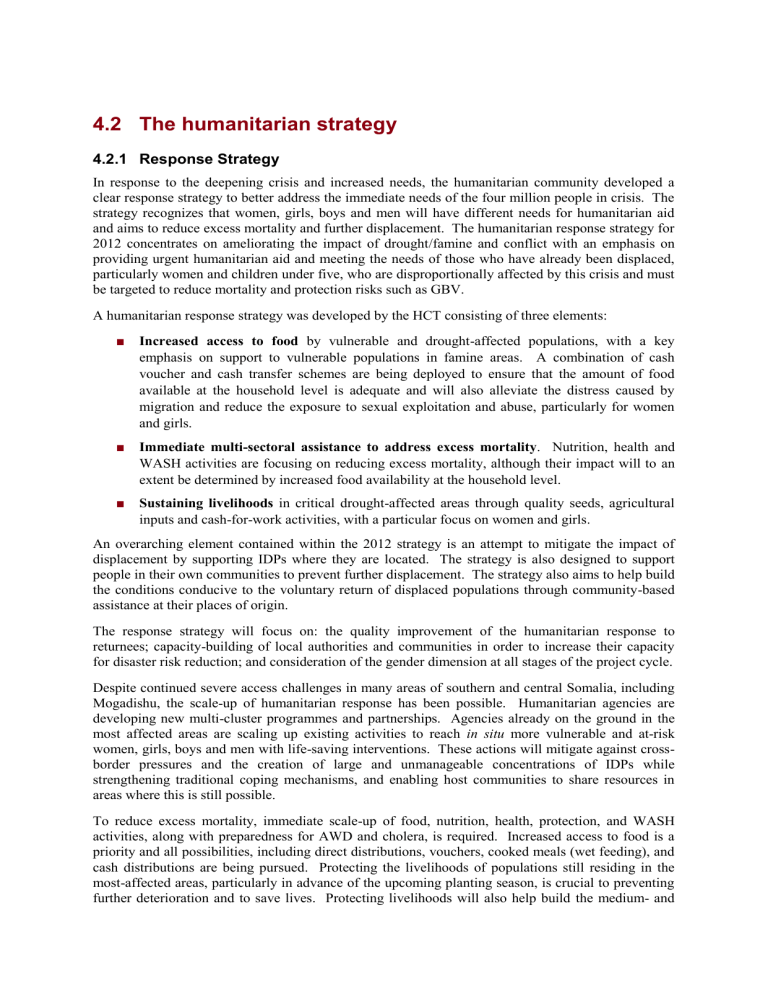
4.2 The humanitarian strategy
4.2.1 Response Strategy
In response to the deepening crisis and increased needs, the humanitarian community developed a clear response strategy to better address the immediate needs of the four million people in crisis. The strategy recognizes that women, girls, boys and men will have different needs for humanitarian aid and aims to reduce excess mortality and further displacement. The humanitarian response strategy for
2012 concentrates on ameliorating the impact of drought/famine and conflict with an emphasis on providing urgent humanitarian aid and meeting the needs of those who have already been displaced, particularly women and children under five, who are disproportionally affected by this crisis and must be targeted to reduce mortality and protection risks such as GBV.
A humanitarian response strategy was developed by the HCT consisting of three elements:
■
Increased access to food by vulnerable and drought-affected populations, with a key emphasis on support to vulnerable populations in famine areas. A combination of cash voucher and cash transfer schemes are being deployed to ensure that the amount of food available at the household level is adequate and will also alleviate the distress caused by migration and reduce the exposure to sexual exploitation and abuse, particularly for women and girls.
■
Immediate multi-sectoral assistance to address excess mortality . Nutrition, health and
WASH activities are focusing on reducing excess mortality, although their impact will to an extent be determined by increased food availability at the household level.
■
Sustaining livelihoods in critical drought-affected areas through quality seeds, agricultural inputs and cash-for-work activities, with a particular focus on women and girls.
An overarching element contained within the 2012 strategy is an attempt to mitigate the impact of displacement by supporting IDPs where they are located. The strategy is also designed to support people in their own communities to prevent further displacement. The strategy also aims to help build the conditions conducive to the voluntary return of displaced populations through community-based assistance at their places of origin.
The response strategy will focus on: the quality improvement of the humanitarian response to returnees; capacity-building of local authorities and communities in order to increase their capacity for disaster risk reduction; and consideration of the gender dimension at all stages of the project cycle.
Despite continued severe access challenges in many areas of southern and central Somalia, including
Mogadishu, the scale-up of humanitarian response has been possible. Humanitarian agencies are developing new multi-cluster programmes and partnerships. Agencies already on the ground in the most affected areas are scaling up existing activities to reach in situ more vulnerable and at-risk women, girls, boys and men with life-saving interventions. These actions will mitigate against crossborder pressures and the creation of large and unmanageable concentrations of IDPs while strengthening traditional coping mechanisms, and enabling host communities to share resources in areas where this is still possible.
To reduce excess mortality, immediate scale-up of food, nutrition, health, protection, and WASH activities, along with preparedness for AWD and cholera, is required. Increased access to food is a priority and all possibilities, including direct distributions, vouchers, cooked meals (wet feeding), and cash distributions are being pursued. Protecting the livelihoods of populations still residing in the most-affected areas, particularly in advance of the upcoming planting season, is crucial to preventing further deterioration and to save lives. Protecting livelihoods will also help build the medium- and
long-term resilience of vulnerable communities, including in poor urban and rural households in accessible areas of the north.
Emergency, integrated nutrition programmes are focused on treating the most affected, while simultaneously providing safety nets for other vulnerable populations and improving overall food access. Experiences has shown that in famine situations, health and WASH interventions, closely linked to food and nutrition activities, are required to prevent communicable disease outbreaks, particularly among those on the move and large groups forced to congregate in small spaces. Disease control through surveillance and early warning, vaccinations, and emergency health services, including management of health complications of severe malnutrition, are key actions.
Basic NFIs and shelter for the displaced are essential for survival, and will be coordinated with
WASH, nutrition and food interventions to ensure synergy. Protection will be mainstreamed in the humanitarian response and protection activities will continue to focus on populations on the move, the prevention of and response to GBV and sexual exploitation and abuse, and family reunification.
Child protection activities will be emphasized through joint education and protection interventions, and the scaling-up of education activities in advance of the new academic year in September will be crucial for the thousands of school-age girls and boys who have been displaced. Female teachers will be targeted for retention and recruitment, due to their direct impact on enrolment and retention of girls.
The Assessment and Information Management Working Group was established in August. It is a subworking group of the ICWG, and includes members from the UN and NGO community. The group will focus on regularly updating the survey of surveys, defining common standards for assessments, and refining inter-cluster rapid needs assessment tools. The main objective is to improve data collection for both response programming and monitoring and evaluation. In particular, the group will ensure collection of sex- and age-disaggregated data, and use this information to target the most vulnerable women, girls, boys and men for assistance and protection.
Establishing accurate and current population figures for Somalia remains a challenge for the humanitarian community. In 2011, several inter-agency initiatives were conducted in order to revise
IDP population figures in Abudwaq, Adado, Dusamared, Mataban, Jariban and Galdogob districts as well as in Garowe, Galkayo, and Bossaso towns. Inter-agency efforts are continuing in Mogadishu to obtain accurate IDP population figures in all sixteen districts. CAP plans are still based on the 2005
UNDP population estimates.
As the crisis is likely to continue well into 2012, funding is required at high levels to support aid agencies. While some agencies will likely carry over some funding from 2011, others fear a funding gap in early 2012, while needs will remain high. The first CHF standard allocation of 2012 is planned for February 2012 to fund the highest priority clusters and activities in this CAP. The second 2012 standard allocation will take place in August 2012.
4.2.2 Humanitarian Access Strategy
Access in 2012 will be defined by the humanitarian community’s ability to engage at all levels with non-state armed actors, local authorities, and governments. The strategy will focus on access to populations in need through a two-tiered but parallel approach to negotiations. One tier will continue to engage at the operational level to obtain access for immediate humanitarian actions. while the second tier will focus on access negotiations at the highest possible levels of authority. The strategy recognizes that each region in Somalia has different stakeholders with varied interests; therefore, the two-tiered approach will be tailored to each specific situation. The result will be to obtain immediate access to populations, while at the same time negotiating for greater and unimpeded access where necessary. The HCT’s position on military intervention in Somalia is that further external military intervention would have a counter-productive impact on access.
4.2.3 Risk Mitigation
In order to ensure accountability of humanitarian operations and establish a systematic approach to identifying risks and mitigating against the possible diversion of aid, the United Nations Country
Team (UNCT) has introduced a risk management regime. The Resident Coordinator’s Office now has a unique dedicated Risk Management Unit (RMU) to provide support to the 24 UN entities working in Somalia, as well as to partners and donors. The RMU and introduction of a common approach to risk management are designed to further develop and strengthen a harmonized planning and programming approach among the UNCT, while recognizing and respecting the differing programmatic requirements. This is also to enable more effective and efficient development and humanitarian aid to Somalia.
Since 2010, staff throughout Somalia have received training on the principles and methodologies of risk management. This training has been extended to government partners and enables participants to understand and identify potential and real risks to programming and will assist in better decisionmaking. The Contractor Information Management System (CIMS) is a UN-wide system that allows the UN to share information about the quality and integrity of partners. It aims to reduce risks associated with contracting and improve due diligence processes.
The RMU also provides support when requested to ensure risk management processes and methodologies are integrated into programme planning (in particular joint programmes) and that there are systems in place for monitoring risks.
4.2.4 Preparedness and Contingency Planning
Somalia is prone to recurring, periodic man-made and natural hazards, mainly conflict and drought.
Floods also affect parts of the country, although with less frequency and damage compared to the other shocks. In March 2011, the HCT updated the contingency plan for increased conflict in southern and central Somalia. A contingency plan will be developed for Somaliland and Puntland and a hazard mapping exercise is being conducted in Somaliland as part of this process. In the south, more collaboration with the National Disaster Management Agency will be done to ensure there is adequate coordination between humanitarian plans and envisaged district rehabilitations plans. The capacity of field cluster structures to develop region-based contingency plans will be enhanced.
One key challenge in southern and central Somalia is the limited capacity of agencies to act in a timely manner due to the absence of stocks on the ground. Most agencies have stocks in Kenya and
Puntland. Another limitation is that donor contributions usually only increase when the crisis is being reported by the international media. The humanitarian community will increase its presence in
Mogadishu, Gedo and central regions, and there will be more focus on prepositioning of supplies. All cluster response plans have included elements of preparedness. UNDP, FAO, WFP and OCHA are working on an integrated Disaster Risk Reduction plan in close cooperation with National
Environmental Research and Disaster-Preparedness ( NERAD) in Somaliland, in order for communities and authorities to be better prepared for and able to mitigate the effects of natural and man-made disasters. Existing early warning systems, such as the disease outbreak monitoring and response system, and the population movement tracking system, will be strengthened. The CAP 2012 recognizes the possible extension of the current famine to more regions and the cluster response plans are being developed with this in mind.
4.2.5 Coordination Strategy
Inter-cluster coordination is taking place regularly in Nairobi, Somaliland, Puntland and southern and central Somalia. Coordination in southern and central Somalia is weaker than in other zones, although considerable improvement has been made in Mogadishu. The existing ICWG will be strengthened while efforts will be made to create at least three more similar forums in southern and central Somalia (in Hiraan, Jubas and Bay). This is contingent on access and the security situation.
However, Mogadishu remains the main focus for strengthening coordination in the south. The GBV
WG in Nairobi is currently focusing on strengthening the GBV WG in Mogadishu through the
Protection Cluster. Two GBV Coordinators will be based full-time in Mogadishu to strengthen response and coordination due to the increase in sexual violence reported.
The Agriculture and Livelihood Cluster and Food Assistance Cluster will be merged into one single
Food Security Cluster commencing in January 2012 in order to enhance the output of the response to address food insecurity, malnutrition and livelihoods. Individual clusters will deploy strong field coordination focal points in Mogadishu. The Health, Nutrition and WASH Clusters will take the lead due to the increasing number of humanitarian partners. In light of the increased disease risks in
Mogadishu, the Health Cluster will place an international staff member to lead. Other clusters will increase support with experienced national staff and regular visits from international staff. With the arrival of many new humanitarian partners, coordination and cooperation needs to remain a priority and efforts will be continued to ensure participation in coordination structures. Various Red Cross and Red Crescent Societies are coordinated by the ICRC and the Somalia Red Crescent Society (with some exceptions). The humanitarian forum will continue to ensure that Islamic NGOs engage in coordination structures. OCHA and the Organisation for Islamic Cooperation will continue to cooperate closely and strengthen their partnership and benefit from each other’s expertise to improve coordination on the ground.
Attention will also be paid to coordination with government authorities in Puntland and Somaliland and with the TFG in the south. TORs have been written for posts in the Humanitarian Liaison Unit and will be filled. UNDP has provided an additional post in the Disaster Management Agency. There are on-going discussions between the local district administrations and the TFG. As a result of the roadmap, the TFG may take a broader national role. There is a great need for tracking humanitarian receipts by the government as a basic element of coordination and accountability. OCHA is now able to identify assistance coming into the country through Mogadishu and a tracking system of where the assistance is delivered will be established.


